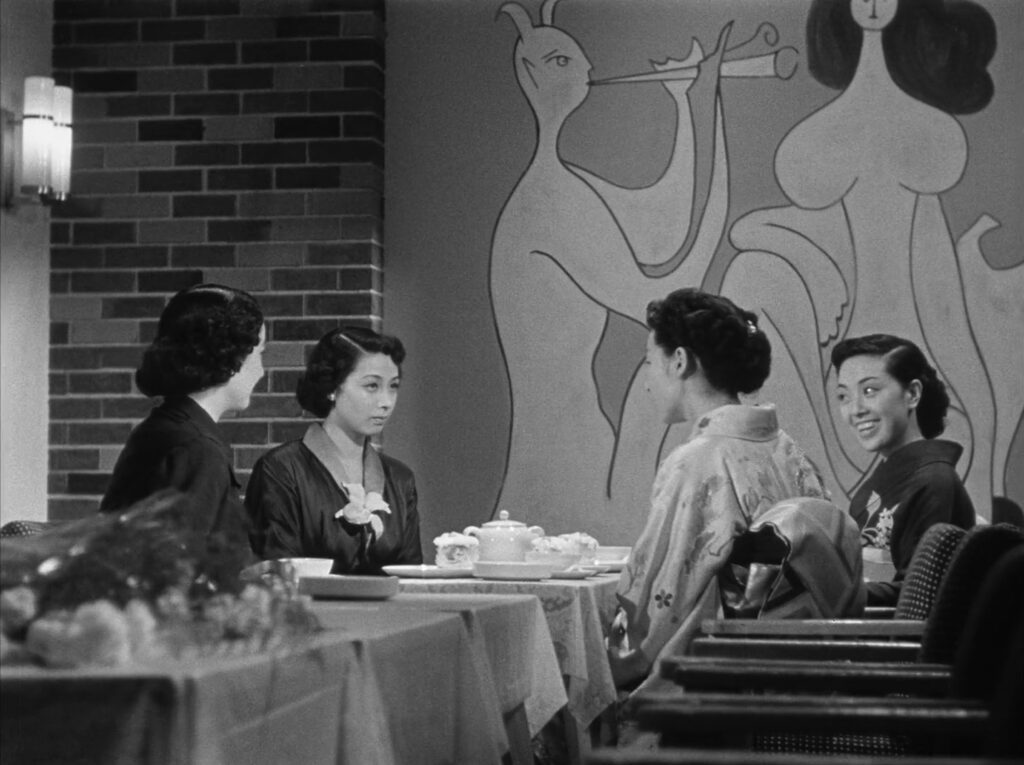
Early Summer
1951, directed by Yasujiro Ozu
The easiest mistake we could make about Early Summer would be to say that its likeness to other Ozu films, especially Late Spring, is a matter of style or Ozu “repeating his themes”. Certainly this and Late Spring share a lot in common, including their stories – Setsuko Hara plays a woman in her late 20s named Noriko who gets married after holding out against pressure from her family. The casts and character names overlap, and the families in both films live in Kamakura, a coastal town south of Yokohama famous for its old temples and shrines. The family in Late Spring attends a Noh play, and in Early Summer a Kabuki play. In each film the only train ride seen is a commute to Tokyo, but there are also boys playing with a model train. The fateful day in each plot, when talk of marriage gets serious, is prefaced by a clock chiming late at night and a kitchen light turning off. Each film contains references to Coca-Cola, tea & coffee, and baseball. The point of these parallels, however, is to offset a fundamental difference.
Early Summer begins as Late Spring had ended, with waves washing onto a beach. Placing the incoming waves at the opposite end of the film implies a reversal. It’s unlikely that Ozu wanted to negate everything he had said only two years earlier, but the difference is not just formal – it changes the film’s emotional effect, and in so doing it defines a new attitude toward the flow of life. In Ozu’s films the ocean is associated with unchanging or eternal time, and the ending of Late Spring assures the viewer that the momentous changes we’ve seen – whether personal or cultural, leaving one’s parents to get married or shifting from tradition to modernity – belong to an eternal process like waves lapping the sand. It’s entirely normal to end a movie with a feeling of eternity, but it’s rare to begin a movie that way. By starting Early Summer with that shot of the ocean, Ozu must have been conscious that it would set up an uncommon emotional arc and prepare for an extraordinary ending.
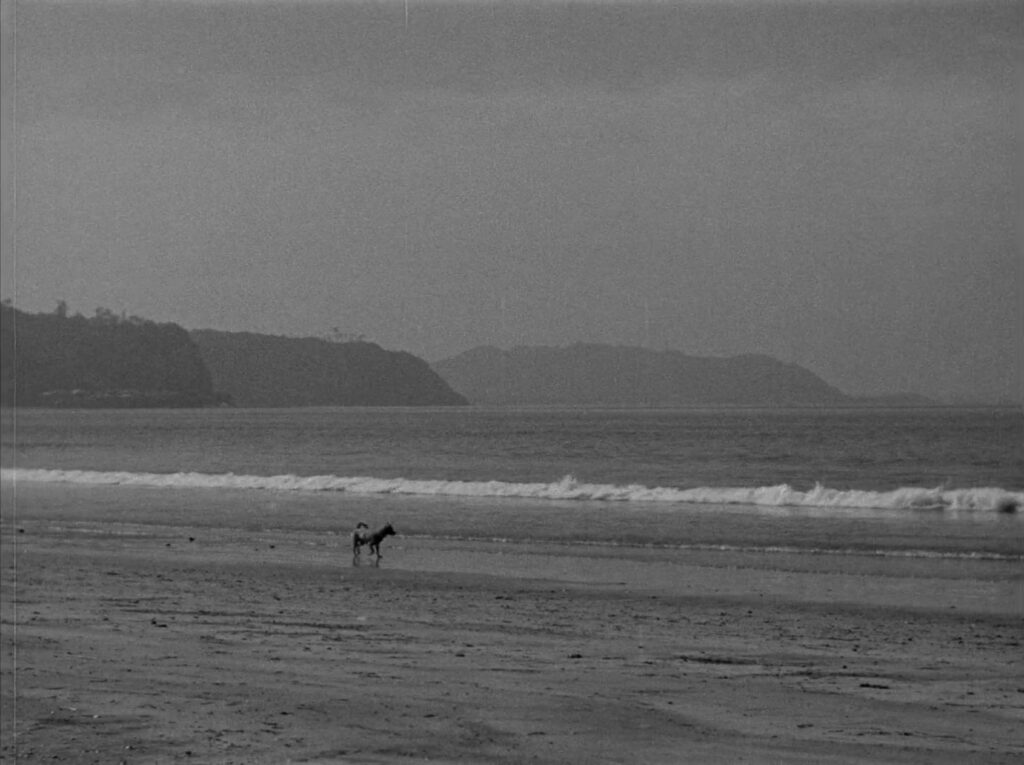
There is one big difference in the ocean shot this time. A dog scampers from left to right across the beach, a small distraction from the sense of eternity, pulling us not so much into a narrative flow (we can hardly expect much story around this dog) but into a particular present. The following shot introduces the Mamiya family’s home with a bird cage hanging in front of a wooded hillside. This opening scene will depict the ordinary comings and goings of the household at breakfast time. Like a bird in a cage (whose grid reflects the wood lattices of Japanese domestic architecture), there’s a lot of lively motion but also a feeling of stasis. Things happen as they’ve always happened. The dialogue throughout this scene is exclusively matter-of-fact, devoid of drama:
“Breakfast, Grandpa. Come on.” “I’ll be right there.” “I told him.” “Put this on the table.” “Some pickles.” “Thanks. Where’s Isamu?” “Isamu! Isamu!” “Did you wash your face?” “Yes.” “No you didn’t. Your face is dirty.” “Hurry up.”
…and so on. There’s nothing you might not hear in any normal family anywhere in the world. In contrast to the conceptual picture of eternity at the seaside, now we find a living picture of eternity – life as it’s always been and always will be… or at least, so it seems in the moment. To this end it’s essential that the scene contains a minimum of emotion. There’s a mild joke about Isamu moistening a towel to cover a childish lie, but we’re left to take note of the humor without reacting strongly.
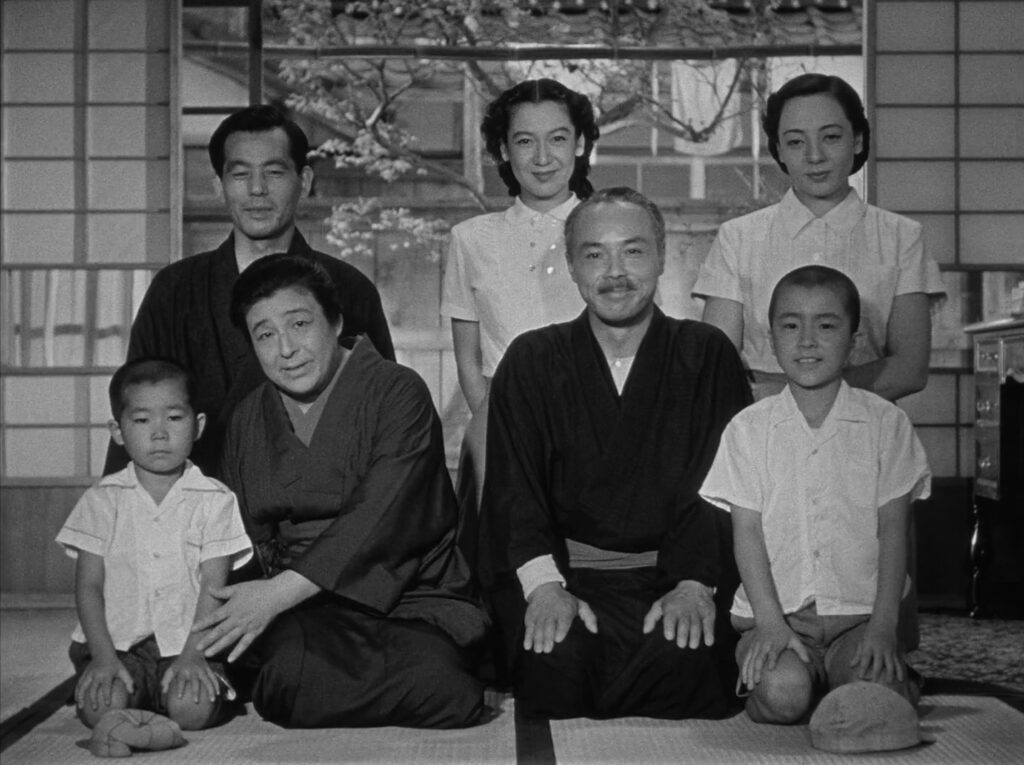
In its action and dialogue the breakfast scene is resolutely quotidian, but it’s underscored by a music box playing the famous Home Sweet Home (which is popular in Japan). Despite – or because of – the lack of drama, there’s something ideal in the Mamiyas’ domestic life that the song expresses, but a cut to Koichi’s Tokyo-bound train abruptly shatters this loving picture of eternal domesticity. In Ozu’s cinematic code, trains represent linear or narrative time. Without anything unusual happening, the train tells us that a story will emerge, and that the family’s life must change. The music box playing Home Sweet Home will return twice – first, forty-five minutes in, when Noriko returns from a wedding and tells Fumiko about her circle of friends drifting apart; and again near the end when her family begins to scatter. Noriko will move north to Akita with her new husband, and her parents will move in with her uncle in Yamato, west of Yokohama. Whereas Late Spring had ended with a sense of constancy, Early Summer goes out of its way to acknowledge the impermanence of any felicitous state of life.
After the interlude with the trains to Tokyo, the next three scenes all begin, like the breakfast, with ordinary habitual activity. The grandfather cuts his grandson’s toenails; Noriko assists her boss at work; and Noriko meets her brother and sister-in-law for dinner. Now, however, emotions start to appear. Isamu says “I love you” every time his grandfather gives him a cookie, then “I hate you” when he’s done. Noriko tells her boss about a friend marrying her long-time crush, and Mr. Satake makes fun of her. At dinner Koichi’s wife and sister unite against his male chauvinism. Emotions will remain in the forefront until the end. The nirvana-like interplay of the breakfast scene was too good to last.
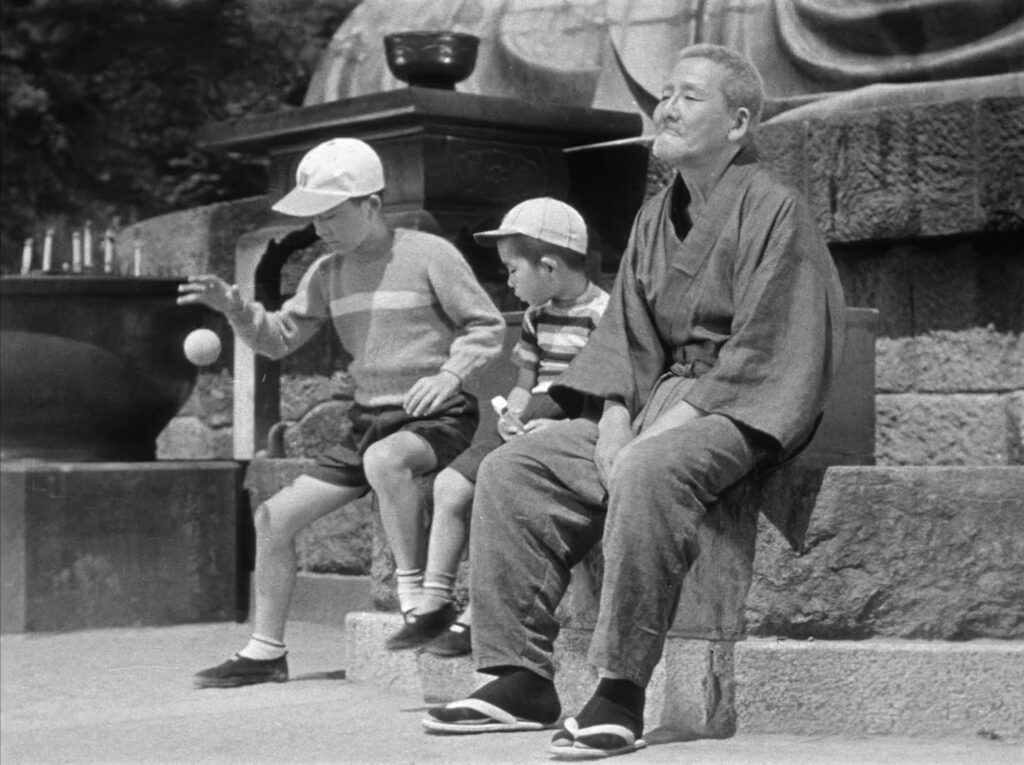
Like most of Ozu’s films, Early Summer switches between the modes of time that define the experience of life. Sometimes forward or narrative time dominates; at other times there’s a sense of cyclical flow; and occasionally life settles into the timeless feeling that the end of Late Spring had reached for. Images of the ocean or water – or any sense of the eternal – are fleeting in Early Summer, always switching abruptly to another mode of time like when the train cuts the breakfast scene off. Noriko and Fumiko walk on the beach, leaving their serious discussion behind on the dunes, but their momentary harmony cuts to office buildings in Tokyo – modernism pushing life forward. The two boys go to the seaside to vent their rage over an expected gift, but then they go to the train station, symbolically re-entering the flow of narrative. When Shige thinks of her dead son she looks out at the koinobori (carp streamers, another image of water) blowing in the wind, but those cut quickly to children jumping rope (a new generation). A shot of a Buddha cuts to boys bouncing a ball at the statue’s base. After passing some grave markers (eternity), Shukichi watches a train go by (forward time).
The movie is unusually perceptive about children’s sense of time. Deprived of agency, they often feel stuck in time and treasure its advancement. The boys own a small model train loop, but their friends awaken an envious desire for more tracks. Their father, who thinks only of nourishing them, disappoints them when he brings home a loaf of bread instead.
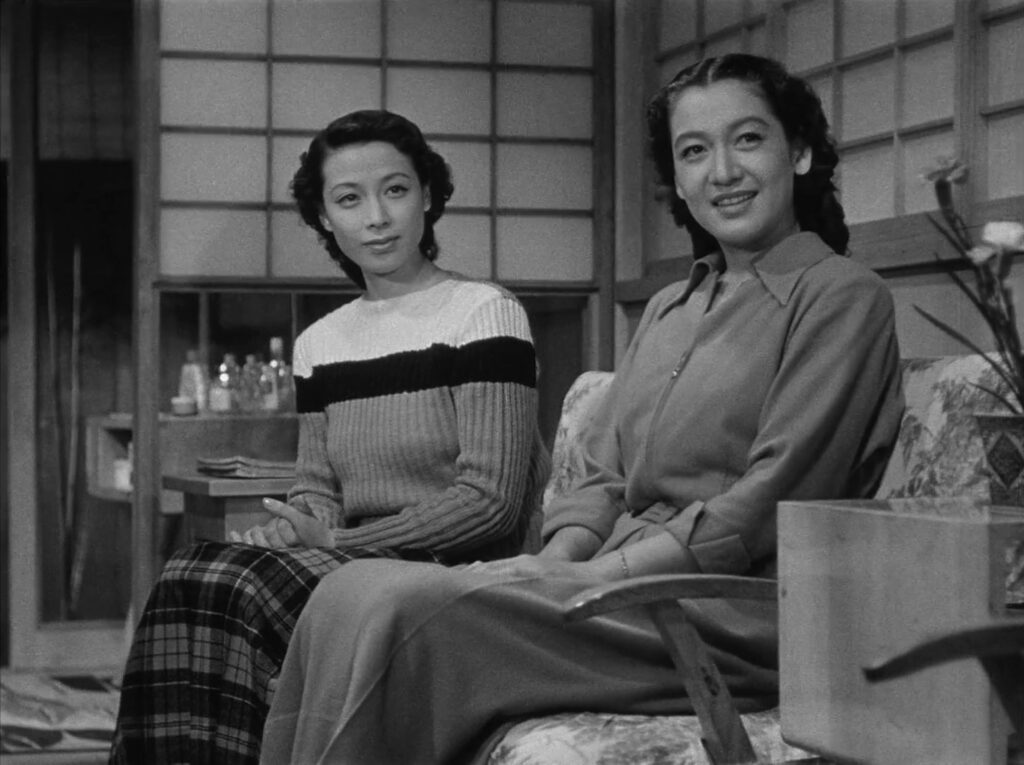
Early Summer doesn’t have quite the allegorical force of Late Spring, but Noriko’s story still must have spoken to the social situation of 1951. By then Japan’s modernization was taken for granted, and the economy was rebounding from the ruins of war. Like so many ordinary people, Noriko faced pressure to seize opportunities – to marry a successful businessman – but she chooses a struggling doctor instead who is familiar and dependable. There’s a possible note of allegory when the elderly couple looks up at a stray balloon, a subliminal image of Japan’s flag as the dark circle starts in the middle of the frame against the clouds then drifts away from the center, suggesting a country adrift in change. In the second shot it approaches the center again before veering off. The difficulties of change are a matter of perspective, and any sense of stability is fleeting.
Ozu was philosophical enough to realize that a movie’s challenge is to define and to reach a proper ending. Late Spring had done its job well, but like most films it moves toward an emotional resolution. In Early Summer he was acutely aware that resolution is fragile. The sense of eternity that movies typically reach for may play a large part in our lives, but it doesn’t last long, and Ozu must have wanted something more tangible for the end of Early Summer. There are really two endings. The plot closes with the family on the verge of separating, and Noriko – who’s been cheerful through everything, and who gets her way – goes upstairs to cry. There is enough happening here that it cannot be summed up in a single emotion. There’s no real pathos, and the audience is free to find its own reaction, which may well change from one viewing to another.
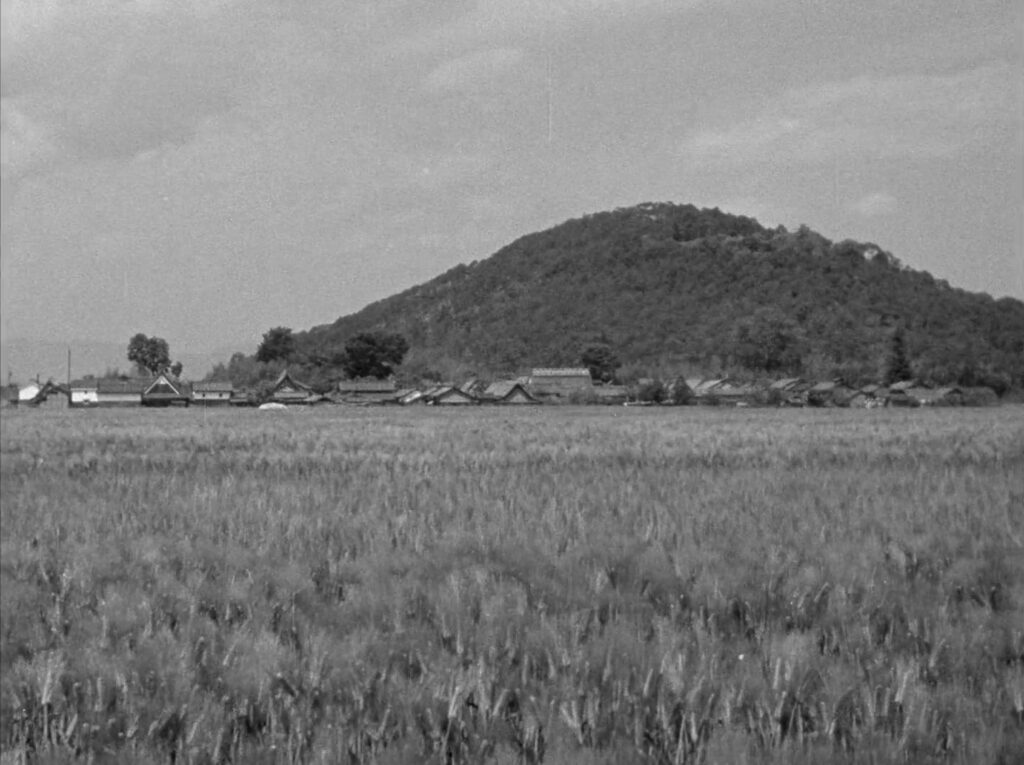
The next shots take us to Noriko’s parents at her uncle’s home beside the barley fields at the edge of the foothills. The Japanese title Barley Harvest Time points directly to this scene, underscoring its importance. A bridal procession outside prompts Shige to wonder how Noriko is doing, and the couple reflects on their past happiness. The final three shots show an increasingly broader perspective of the houses, implying the breadth of vision that the last shot will capture as it sums up the whole experience of time. The camera tracks from left to right, one of Ozu’s rare camera movements, suggesting linear time, a continuation of life – yet neither the hill nor the houses in the background move significantly. The wind ripples the barley like waves in the ocean, and the ripe grain with the recent memory of the bridal procession brings seasons and generations into the mix. In short, the image balances all three modes of time – linear, eternal, and cyclical. With just a few cinematic brushstrokes, the ending thus captures the paradoxical combination of feelings that result from living through time.
CONNECTIONS:
The Wizard of Oz – Protagonist finds at the end what was close to her all along; “There’s no place like home” spoken or implied musically
Lumière d’été – Subliminal icon of the nation in the sky
Late Spring – Waves on a beach; Noriko’s decision to wed; Kamakura; Noh or Kabuki play; Chishu Ryu riding a train to Tokyo; boys playing with a model train; chimes and light off on the night before talk of marriage turns serious
The Flavor of Green Tea over Rice – Young woman resists a marriage arrangement; nearly identical shots of a kabuki theater
Tokyo Story – Deliberate demarcation between matter-of-fact speech and emotional dialogue
Pather Panchali – Period of stasis at the beginning that depicts everyday family life
The Burmese Harp – Japanese movie with prominent use of the song Home Sweet Home
La notte – Reversal of normal placement of the eternal at the end
The End of Summer – Daughter who resists her family’s arranged marriage and will move north with the man of her choice
Nostalghia – Film opens on a cue from a recent film by the same director